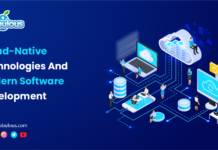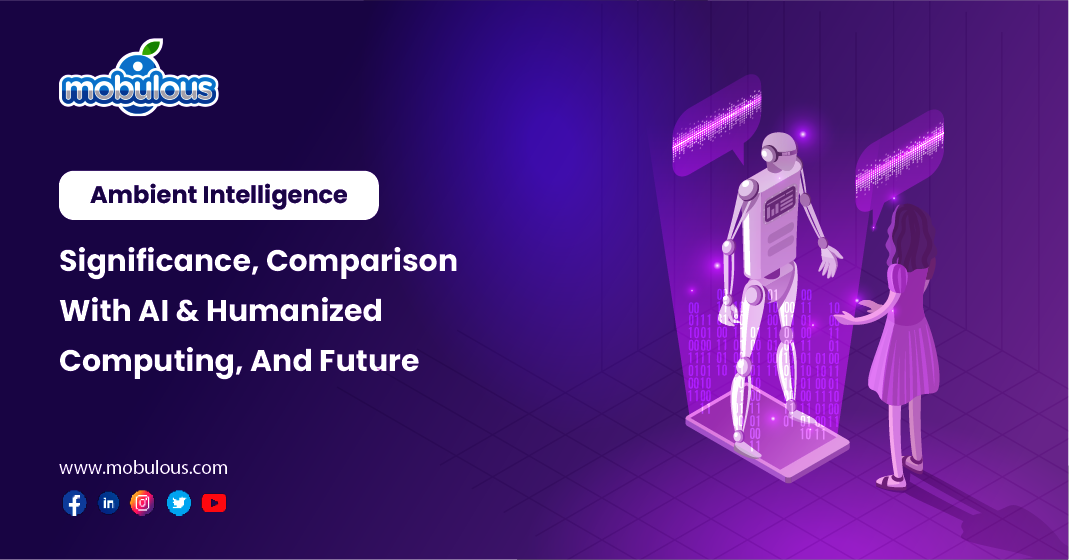Ambient Intelligence: What is it? Significance, Comparison With AI & Humanized Computing, And Future
Ambient technology refers to electronic systems and devices smoothly integrated into our surroundings and operating invisibly while responding to human presence, behaviors, and needs in order to build smarter and more intuitive environments.
In an era where not only mobile app development technology increasingly weaves itself into the fabric of our daily lives but also other immersive technologies like Ambient Intelligence or AmI emerge as a revolutionary paradigm that promises to transform how we interact with our environment.
Imagine a world where your home, hospital, or office understands you, works in harmony with your daily life, and adapts to your preferences. Doesn’t it sound exciting? So, without any further ado, let’s explore what AmI is, its significance, how it compares with AI, and what the future holds for this transformative technology.
What is Ambient Intelligence?
Ambient Intelligence or AmI represents a vision of future technology where our surroundings become responsive and intelligent. It builds environments that are adaptive, responsive, and sensitive to human needs and presence.
Just imagine that your home automatically adjusts its lighting, temperature, and music as per your mood, activities, and time of the day without any explicit commands.
The core characteristics of AmI or ambient technology include the following:
- Context awareness
- Seamless integration into everyday objects
- Natural and intuitive interaction
- Anticipatory behavior
- Adaptive response mechanisms
Also Read:- Indispensable Role of Artificial Intelligence in App Development!
What is Ambient Technology?
Ambient technology or Ambient tech simply refers to a sophisticated network of electronics embedded invisibly within our environment. These systems leverage processors, sensors, and smart devices in order to build responsive spaces that adapt to human needs.
Unlike traditional technology that mandates active and frequent interaction, Ambient tech works silently in the background, predicting needs, monitoring surroundings, and adjusting environmental parameters automatically like temperature, lighting, and security.
It generally forms the foundational infrastructure that allows ambient intelligence or AmI to function properly and effectively, making it a smooth technology for businesses worldwide.
What Are Ambient Intelligence and Ambient Computing?
Ambient computing is the foundation of ambient technology that requires effective and high-performance architecture, scaling to support devices everywhere with technologies like AI and ML (Artificial Intelligence and Machine Learning) to comprehend and anticipate the necessities of the humans in the environment and react autonomously.
Just think about hanging out with your friends in a smart city where your autonomous vehicle drops you off at your destination and self-parks or you walk into your restaurant with your better half and your desired table is all set for your date. Doesn’t it sound fascinating?
Yes, and this is only made possible by ambient intelligence based on a highly scalable ambient computing architecture.
Also Read:- How Artificial Intelligence can be Used in the Mobile Apps?
The Concept of Intelligent Environments
Ambient Intelligence or AmI is revolutionizing different industries, including healthcare, smart cities, retail, etc, by integrating AI/ML, cloud computing, IoT, and sensors into daily environments.
This innovation builds highly adaptive and intelligent spaces that sense, learn, and respond to human requirements, making interaction effective and smoother. AmI transforms ordinary spaces into savvy environments that can:
- Detect and respond to human actions in real-time.
- Adapt settings based on user behavior and preferences.
- Improve efficiency and convenience without manual intervention.
This concept is extensively used in workplaces, smart homes, retail spaces, public environments, and healthcare facilities and offers an intuitive and seamless user experience. Unlike conventional automated systems, AmI-powered environments lean continuously and optimize interactions for improved productivity and comfort.
For Query:- Seek Guidance From an IoT App Development Company!
Ambient Intelligence Systems: The Building Blocks
Ambient Intelligence systems solely depend on key components like the sensing layer, processing layer, action layer, integration layer, user interface layer, and learning & adaptation layer to build adaptive environments.
These elements work together to enable intelligent decision-making, real-time sensing, automation, and seamless human-computer interaction for enhanced user experiences. Let’s learn about this building block in a more comprehensive way:
1. Sensing Layer: The Environmental Gateway
The sensing layer acts as the fundamental interface between the physical world and the ambient intelligence system. Environmental sensors for a comprehensive network throughout the space that monitors humidity, temperature, air quality, and light levels continuously.
These sensors work in concert in order to build a comprehensive environmental profile that ensures optimal efficiency and comfort.
- Biometric sensing potential extends the system’s awareness to human occupants. Advanced sensors track crucial signs, psychological states, and movement patterns.
- Through facial recognition and gait analysis, the system creates a nuanced understanding of specific occupants, allowing for personalized health monitoring and responses.
- Contextual awareness is achieved through complex tracking systems and positioning. These sensors track movement flow, map occupancy patterns, and comprehend space utilization.
- The temporal awareness elements ensure that responses are accurate for the current activities and time of day.
2. Processing Layer: The Intelligent Core
At the core of ambient intelligence lies the processing layer, where raw sensor data transforms into actionable intelligence. This layer incorporates powerful data collection mechanisms that aggregate inputs from multiple sources, applying sophisticated filtering algorithms to ensure data quality and relevance.
- The system maintains both cloud-based and local storage solutions that enable rapid access while preserving historical patterns for long-term analysis.
- The analytical engine utilizes machine learning algorithms in order to identify patterns and anticipate requirements. The predictive potential enables the system to predict necessities rather than simply react to them.
- The intelligence element continuously processes its understanding of behavioral patterns and user preferences, leading to increasingly accurate and appropriate responses over time.
Rule processing systems manage the advanced interplay of environmental conditions, user preferences, and system capabilities.
These systems manage emergency protocols, handle priority conflicts, and ensure that all actions align perfectly with pre-determined comfort and safety parameters.
3. Action Layer: The Response Mechanism
The action layer manifests the system’s decisions through a network of integrated control systems. Below are the main points that are considered the response mechanisms of the action layer in ambient intelligence:
- Environmental controls adjust lighting, ventilation, and temperature with subtle precision. These adjustments occur seamlessly to maintain optimal conditions without drawing attention to the fundamental technology.
- Communication systems ensure that all stakeholders remain informed of relevant system actions and states. These systems handle everything from routine status updates to emergency notifications to scale their response depending on priority and urgency. This framework handles continuous dialogue between system elements to ensure a coordinated response to changing prerequisites.
- The automation component produces an advanced series of actions across different subsystems. This production considers factors like user comfort, energy efficiency, and system optimization.
- The response system ensures that all actions occur in a coordinated and suitable manner in order to maintain system stability while achieving preferred results.
4. Integration Layer: The Unifying Framework
The integration layer binds different system elements into a cohesive whole. Device connectivity management ensures trusted communication between all system components, managing protocol differences and maintaining stable connections.
This layer handles and operates the advanced tasks of coordinating diverse subsystems and devices that ensure they work in harmony rather than conflict.
- System coordination extends beyond simple device management in order to encompass load balancing and resource allocation.
- This coordination ensures optimal system performance while preventing resource conflicts or overloads.
The integration layer maintains system stability while promoting comprehensive reconfiguration as needs and requirements change.
5. User Interface Layer: The Human Connection
Natural interaction methods develop an immersive bridge between users and the AmI system. Below are the types of human connection functionalities that ambient intelligence contains:
- Voice control, touch interfaces, and gesture recognition provide different pathways for user interaction. These interfaces adjust to user capabilities and preferences, ensuring accessibility for all occupants.
- Feedback mechanisms provide subtle and clear indications of system actions and status.
- Through an amalgamation of haptic, auditory, and visual cues the system maintains open and transparent communication with users without being intrusive. This feedback system ensures users remain informed while preserving the ambient nature of the tech.
6. Learning and Adaptation Layer: The Evolution Engine
The learning component examines user interactions and system performance continuously in order to process its operations. The so-called evaluation engine this learning and adaptation layer contains is given below:
- Pattern recognition algorithms identify trends in preferences and usage that bring increasingly advanced responses to user requirements. This transformation capability ensures the system becomes more efficient as time passes.
- System evolution extends beyond simple pattern recognition in order to encompass extensive optimization of all system elements.
- Performance monitoring and health management systems ensure stable operation while recognizing possibilities for enhancement. This consistent evolution results in an increasingly advanced and capable ambient intelligence system.
Real-World Examples of Ambient Technology
Ambient intelligence is revolutionizing our day-to-day environments into brilliant spaces that foresee and respond to human requirements. The highly notable implementations that display its practical and real-world applications are mentioned below:
1. Smart Healthcare Monitoring Systems
Hospitals and clinic centers are now enforcing ambient sensors that consistently monitor patient movement, vital signs, and room conditions without intrusive devices. These systems alert medical staff to track patient recovery patterns, and emergencies, and adjust room environments automatically.
Massachusetts General Hospital reported an approximately 60% reduction in response time to critical situations after implementing ambient monitoring systems.
2. Intelligent Home Lighting
Philips Hue and various other similar systems develop responsive lighting environments that adjust to occupant activities, natural light levels, and day-to-day schedules.
These systems learn user preferences over time, color temperature, and adjust brightness automatically in order to support circadian rhythms and improve comfort while reducing energy consumption by up to 37%.
3. Amazon’s Just Walk Out Technology
This ambient intelligence retail system leverages sensor fusion, computer vision, and deep learning in order to detect when products are returned to or taken from shelves automatically.
Customers can simply walk out with their products, and their accounts are automatically charged, removing checkout cues and revolutionizing the shopping experience.
4. Smart Office Environments
Modern office buildings leverage ambient intelligence systems that monitor temperature, occupancy, and air quality. These systems adapt to lighting, HVAC settings, and workspace arrangement, depending on real-time usage patterns.
Firms report up to 25% energy savings and enhanced employee productivity through the implementation of the AmI systems.
5. Automotive Ambient Intelligence
Modern vehicles blend ambient intelligence systems that oversee driver alertness, improve safety, and adjust cabin prerequisites.
These systems leverage sensors in order to detect driver fatigue that adjust mirrors & seats and maintain optimal cabin temperatures automatically, depending on eternal conditions and individual preferences.
Key Features of Ambient Intelligence
Ambient intelligence or AmI is characterized by different features that allow for smooth interaction between humans and technology. The highly crucial features that define AmI systems are given below comprehensively:
1. Context Awareness
Ambient Intelligence or AmI possesses advanced environmental discernment abilities through sensor networks that monitor surroundings consistently.
These systems process diverse data streams in order to comprehend context such as activity patterns, user location, temporal factors, and environmental prerequisites that enable suitable and on-time responses to changing situations.
2. Natural Interaction
The technology fosters intuitive human-computer interaction through natural language processing, behavioral pattern analysis, and gesture recognition.
Users are able to communicate with systems through body movements, conversational interfaces, or even subtle behavioral lines that eradicate the requirement for conventional input devices.
3. Anticipatory Behavior
Through sophisticated artificial intelligence and machine learning (AI/ML) algorithms, ambient intelligence foresees user requirements and preferences before explicit requests.
The technology examines historical patterns, real-time data, and current context in order to adjust environmental parameters and initiate suitable actions proactively, creating a truly responsive environment.
Also Read:- What are the Advantages of Artificial Intelligence & Machine Learning in Mobile Applications?
4. Adaptive Response
Ambient intelligence systems showcase dynamic adaptation to changing user preferences and circumstances. The AmI technology consistently learns from interactions that refine its responses as time passes.
This simply includes adjusting environmental parameters, evolving its decision-making processes, and modifying interaction patterns based on gathered experience.
5. Seamless Integration
Ambient Intelligence technologies incorporate invisibly into the environment, operating without requiring conscious user attention.
The integration expands to physical infrastructure, existing systems, and day-to-day objects, building an intelligent and unified environment that improves rather than disrupts daily activities.
6. Privacy and Security
Sophisticated encryption and authentication mechanisms safeguard system integrity and user data. These systems enforce advanced privacy preservation protocols that ensure user confidentiality while maintaining functionality.
They include granular control over data sharing and highly powerful security measures against unauthorized access.
Ambient Intelligence vs Artificial Intelligence
While AI or Artificial Intelligence emphasizes developing smart systems, AmI or Ambient Intelligence specifically applies AI and other robust technologies in order to build highly engaging and responsive environments that smoothly integrate into daily life and activities. The below table on ambient intelligence vs artificial intelligence will provide you with a comprehensive comparison of the two:
| Aspect | Ambient Intelligence (AmI) | Artificial Intelligence (AI) |
| 1. Core Purpose | 1. Focuses on creating responsive environments that seamlessly integrate technology into everyday life.
2. AmI systems work in the background to anticipate and fulfill user needs through environmental sensing and adaptation, prioritizing natural interaction and user comfort. |
1. Concentrates on developing intelligent systems that can simulate human cognitive functions.
2. AI systems are designed to solve complex problems, make decisions, and perform tasks that typically require human intelligence, often operating as standalone solutions. |
| 2. Integration Method | 1. Embedded invisibly within physical environments through networks of sensors, actuators, and processing units.
2. AmI systems become part of the infrastructure, operating without requiring direct user attention or interaction while maintaining constant environmental awareness. |
1. Can exist as standalone software or be integrated into specific devices.
2. AI systems typically require explicit interaction or input, functioning as distinct tools or services rather than becoming part of the environment itself. |
| 3. User Interaction | 1. Emphasizes natural, implicit interaction through environmental sensing and context awareness.
2. Users interact with AmI systems through normal daily activities, with the technology responding automatically to behavioral patterns and needs. |
1. Often requires explicit interaction through specific interfaces or commands.
2. Users must actively engage with AI systems through defined channels, such as voice commands, text input, or graphical interfaces. |
| 4. Learning Approach | 1. Learns primarily from environmental patterns, user behaviors, and contextual changes within specific spaces.
2. Learning is continuous and location-specific, focusing on adapting to regular occupants and their routines. |
1. Learns from diverse data sources, including structured databases, user inputs, and online information.
2. Learning can be broader and more generalized, not necessarily tied to specific physical spaces. |
| 5. Response Time | 1. Operates in real-time with immediate environmental responses to changing conditions or user needs.
2. Reactions are often proactive, anticipating requirements before explicit requests are made. |
1. Can operate in both real-time and batch processing modes, depending on the application.
2. Response times may vary based on computational requirements and data processing needs. |
| 6. Data Collection | 1. Gathers data primarily through environmental sensors, focusing on physical parameters, user presence, and behavioral patterns within specific spaces.
2. Data collection is continuous but localized. |
1. Collects data from various sources, including user inputs, databases, and online repositories.
2. Data collection can be broader in scope but may not be continuously active. |
| 7. Application Scope | 1. Primarily focused on creating intelligent environments in specific physical spaces like homes, offices, or healthcare facilities.
2. The scope is typically bounded by the physical infrastructure where the system is installed. |
1. Can be applied across various domains without physical limitations, from data analysis to autonomous systems, virtual assistants, and complex problem-solving applications. |
| 8. Decision Making | 1. Makes decisions based on immediate environmental context, user patterns, and predefined comfort or efficiency parameters.
2. Decisions are typically focused on environmental control and user comfort. |
1. Makes decisions based on complex algorithms, pattern recognition, and predefined rules across various domains.
2. Decisions can range from simple classifications to complex strategic choices. |
| 9. Privacy Considerations | 1. Must handle privacy concerns related to continuous environmental monitoring and personal behavior tracking within physical spaces.
2. Privacy is inherently linked to physical presence and activity patterns. |
1. Privacy concerns focus more on data usage, algorithm transparency, and protection of user-provided information.
2. Privacy issues are often related to data processing and storage. |
| 10. System Evolution | 1. Evolves through continuous learning from specific environmental interactions and user behaviors, developing increasingly personalized responses to regular occupants over time. | 1. Evolves through updates to algorithms, exposure to new training data, and improvements in computational capabilities, often developing broader and more general capabilities. |
Ambient Intelligence vs Humanized Computing
While Ambient Intelligence emphasizes developing responsive environments through embedded technology, Humanized computing focuses on designing systems that adjust to natural interaction and human cognitive processes. These approaches complement each other. Let’s compare ambient intelligence and humanized computing with a comprehensive table:
| Aspect | Ambient Intelligence (AmI) | Humanized Computing (HC) |
| 1. Core Philosophy | 1. Focuses on creating intelligent environments that proactively respond to human needs through embedded technology and sensors.
2. AmI emphasizes invisible integration and autonomous operation to enhance living spaces without requiring conscious interaction. |
1. Centers on making computing systems more accessible and natural for human users.
2. HC prioritizes designing interfaces and interactions that align with human cognitive processes, emotional needs, and natural communication patterns. |
| 2. User Engagement | 1. Operates in the background with minimal direct user engagement, collecting data and responding to needs through environmental sensing and automated adjustments.
2. Users benefit from the system without actively managing or controlling it. |
1. Requires more direct user engagement but makes interactions more intuitive and human-like.
2. Users actively participate in computing tasks, but the interface adapts to their natural communication preferences and cognitive styles. |
| 3. System Architecture | 1. Built around distributed sensor networks, processing units, and actuators embedded throughout physical spaces.
2. The architecture focuses on environmental integration and seamless operation across multiple connected devices. |
1. Structured around user-centric interfaces, emotional recognition systems, and adaptive learning algorithms.
2. The architecture emphasizes human factors and psychological comfort in human-computer interactions. |
| 4. Learning Process | 1. Learning occurs through continuous environmental monitoring and pattern recognition of user behaviors within specific spaces.
2. The system adapts to routines and preferences without explicit training. |
1. Learning focuses on understanding individual user characteristics, communication styles, and cognitive patterns.
2. The system adapts its interface and responses to match user preferences and capabilities. |
| 5. Interaction Model | 1. Relies on implicit interaction through environmental sensing and automated responses.
2. Users interact naturally with their environment while the system responds to their presence and activities. |
1. Emphasizes explicit but natural interaction through voice, gesture, and other human-like communication channels.
2. The system tries to replicate human-to-human interaction patterns. |
| 6. Context Awareness | 1. Primarily focused on physical context: location, environmental conditions, user presence, and activity patterns within defined spaces.
2. Context drives automated system responses. |
1. Emphasizes psychological and social context: user emotions, cognitive state, cultural background, and social situations.
2. Context influences how the system communicates and presents information. |
| 7. Adaptation Methods | 1. Adapts through environmental parameter adjustments and automated responses based on learned patterns and immediate sensor data.
2. Adaptation focuses on physical comfort and efficiency. |
1. Adapts through interface modifications, communication style changes, and response patterns based on user preferences and emotional state.
2. Adaptation focuses on user comfort and understanding. |
| 8. Primary Goals | 1. Aims to create intelligent environments that enhance human comfort and efficiency through automated environmental control and proactive assistance.
2. The focus is on environmental optimization. |
1. Seeks to make computing more accessible and natural by mimicking human communication patterns and understanding.
2. The focus is on reducing the cognitive load of human-computer interaction. |
| 9. User Control | 1. Minimizes the need for explicit user control by automating responses based on learned preferences and environmental conditions.
2. Users maintain override capabilities but rarely need them. |
1. Provides users with more direct control but makes it more intuitive and natural.
2. Users actively guide the system while it adapts to their preferred interaction methods. |
| 10. Application Focus | 1. Primarily applied to physical environments: smart homes, offices, healthcare facilities, and public spaces.
2. The focus is on creating responsive physical environments. |
1. Applied to computing interfaces across various platforms and devices.
2. The focus is on making digital interactions more human-like and accessible. |
Ambient Intelligence in Different Industries
Ambient intelligence or AmI represents the smooth integration of technology into environments and creates adaptive and responsive systems that predict and fulfill human requirements across diverse industries. This technological paradigm revolutionizes how we interact with our surroundings.
1. Ambient Intelligence in Healthcare
In the healthcare industry, Ambient intelligence creates smart medical environments that monitor patient conditions, enable proactive care delivery, and automate routine tasks consistently.
This technology integration improves patient safety, enhances treatment outcomes, and supports healthcare professionals in decision-making through context-aware systems.
For Query:- Seek Help From a Healthcare App Development Company!
Key Applications:
- Patient Monitoring: Real-time vital signs tracking and automated alerts for medical staff.
- Smart Rooms: Automated environment control and patient comfort management systems.
- Care Coordination: Intelligent scheduling and resource allocation for optimal healthcare delivery.
- Medication Management: Automated dispensing systems and adherence monitoring through smart devices.
- Clinical Decision Support: AI-powered diagnosis assistance and treatment recommendation systems.
Example:
- Smart hospital beds with integrated vital monitoring.
- Automated medication dispensing cabinets.
- Voice-controlled patient room environments.
- Wearable health monitoring devices.
- Smart waiting room management systems.
2. Ambient Intelligence in Smart Homes
Smart homes utilize Ambient Intelligence in order to create living spaces that adjust to occupants’ behaviors and preferences. These systems integrate diverse technologies in order to improve security, comfort, and energy effectiveness while providing smooth automation of day-to-day tasks and environmental controls.
Key Applications:
- Environmental Control: Automated temperature, lighting, and air quality management systems.
- Security Management: Intelligent surveillance and access control for enhanced home protection.
- Energy Optimization: Smart metering and automated energy consumption management solutions.
- Comfort Automation: Personalized environment adjustments based on occupant preferences.
- Safety Monitoring: Integrated emergency detection and response systems for residents.
Example:
- Voice-controlled lighting and temperature systems.
- Smart door locks with facial recognition.
- Automated window blinds and climate control.
- Intelligent kitchen appliances and cooking systems.
- Motion-sensitive security cameras.
3. Ambient Intelligence in Retail
Retail environments leverage Ambient intelligence in order to create intuitive shopping and e-commerce experiences, comprehend customer behavior, and optimize operations. This technology promotes inventory management, personalized marketing, and improved customer service through smart AmI systems.
For Query:- Seek Help From an eCommerce App Development Company!
Key Applications:
- Customer Analytics: Real-time tracking and analysis of shopping patterns.
- Inventory Management: Automated stock monitoring and replenishment system implementation.
- Personalized Marketing: Context-aware promotional content delivery to individual shoppers.
- Store Operations: Smart lighting and environmental control for optimal shopping.
- Security Systems: Integrated surveillance and loss prevention technology solutions.
Example:
- Smart shopping carts with navigation.
- Interactive digital signage displays.
- Automated checkout systems.
- Temperature-sensitive product monitoring.
- Virtual fitting rooms.
4. Ambient Intelligence in Manufacturing & Industry 4.0
Manufacturing facilities enforce Ambient Intelligence in order to build factories where systems, machines, and processes communicate smoothly. This integration allows for optimized production, predictive maintenance, and improved worker safety through smart monitoring.
Key Applications:
- Process Automation: Smart control systems for manufacturing line optimization.
- Quality Control: Real-time monitoring and defect detection in production.
- Safety Management: Intelligent workplace monitoring for employee protection systems.
- Resource Optimization: Smart energy and material usage monitoring systems.
- Maintenance Planning: Predictive maintenance scheduling through sensor data analysis.
Example:
- Automated guided vehicles in warehouses.
- Smart tool tracking systems.
- Real-time production monitoring dashboards.
- Robotic assembly lines.
- Environmental monitoring systems.
5. Ambient Intelligence in Transportation & Smart Cities
Smart cities integrate Ambient intelligence in order to enhance urban mobility, improve public services, and develop sustainable environments. This AmI tech allows for effective traffic management, enhanced citizen services, and reduced energy consumption.
Key Applications:
- Traffic Management: Real-time monitoring and control of urban traffic.
- Public Transport: Smart scheduling and passenger flow optimization systems.
- Infrastructure Monitoring: Automated maintenance and repair detection systems.
- Environmental Control: Air quality and noise pollution monitoring solutions.
- Citizen Services: Interactive information and service delivery platforms.
Example:
- Smart traffic signal systems.
- Real-time bus tracking.
- Intelligent parking guidance.
- Air quality monitoring stations.
- Smart street lighting.
6. Ambient Intelligence in Education
Educational environments leverage Ambient intelligence in order to build adaptive learning spaces that improve student engagement and foster personalized learning experiences. This technology allows for smart classrooms and interactive learning environments.
Key Applications:
- Learning Environment: Smart classroom management and environmental control systems.
- Student Engagement: Interactive learning tools and participation monitoring platforms.
- Resource Management: Automated scheduling and facility utilization optimization.
- Safety Systems: Intelligent monitoring and emergency response protocols.
- Performance Tracking: Automated assessment and progress monitoring solutions.
Example:
- Smart boards with gesture control.
- Automated attendance tracking systems.
- Interactive learning pods.
- Environmental comfort monitoring.
- Smart resource scheduling.
7. Ambient Intelligence in Workplaces & Offices
Modern workplaces enforce Ambient intelligence in order to develop comfortable, productive, and effective environments. This AmI tech allows for improved collaboration, smart space management, and enhanced employee well-being.
Key Applications:
- Space Utilization: Smart desk and meeting room management systems.
- Environmental Control: Automated lighting and temperature optimization solutions.
- Collaboration Tools: Intelligent meeting and communication platform integration.
- Security Access: Smart building access and security management.
- Resource Management: Automated facility and equipment tracking systems.
Example:
- Smart desk booking systems.
- Automated meeting room controls.
- Intelligent lighting systems.
- Smart security access points.
- Environmental monitoring stations.
8. Ambient Intelligence in Entertainment & Media
Entertainment venues leverage Ambient intelligence in order to develop intuitive experiences and personalized content delivery. This innovative AmI tech allows for improved user engagement and interactive environments.
For Query:- Seek Help From an Event Mobile App Development Company!
Key Applications:
- Content Delivery: Personalized media streaming and content recommendations.
- Interactive Displays: Smart screens and responsive environmental controls.
- Experience Management: Automated venue and event control systems.
- Audience Analytics: Real-time crowd monitoring and engagement tracking.
- Virtual Reality: Immersive environment creation and control systems.
Example:
- Smart theme park experiences.
- Interactive museum displays.
- Automated concert lighting systems.
- Virtual reality gaming rooms.
- Smart cinema environments.
9. Ambient Intelligence in Agriculture
Agricultural settings enforce Ambient intelligence in order to optimize crop production, farming operations, and resource usage. This AmI technology allows for sustainable farming practices and precision agriculture.
For Query:- Seek Help From an Agriculture Mobile App Development Company!
Key Applications:
- Crop Monitoring: Automated plant health and growth tracking systems.
- Resource Management: Smart irrigation and fertilization control solutions.
- Weather Monitoring: Real-time environmental condition tracking and forecasting.
- Livestock Management: Automated animal health and behavior monitoring.
- Equipment Control: Smart farming machinery and tool management.
Example:
- Smart irrigation systems.
- Automated greenhouse controls.
- Livestock monitoring sensors.
- Crop disease detection systems.
- Weather monitoring stations.
10. Ambient Intelligence in Hospitality & Tourism
Hospitality environments leverage ambient intelligence in order to enrich guest experiences and optimize service delivery. This AmI tech allows for effective facility management and personalized services.
For Query:- Seek Help From a Travel & Hotel App Development Company!
Key Applications:
- Guest Services: Automated check-in and personalized experience management.
- Room Control: Smart environmental and comfort control systems.
- Service Management: Intelligent staff coordination and task allocation.
- Facility Monitoring: Automated maintenance and cleaning schedule optimization.
- Experience Enhancement: Interactive tourism guides and information systems.
Example:
- Smart room key systems.
- Automated climate control.
- Digital concierge services.
- Smart luggage tracking.
- Interactive tourist guides.
Ambient Intelligence: Security and Privacy Challenges & Solutions
Ambient tech systems face essential challenges in safeguarding user data and ensuring system security while maintaining functionality. However, its solutions must balance privacy protection with a smooth user experience. The table given below will help you understand vital security and privacy challenges along with their solutions:
| Challenge | Description & Impact | Solution & Implementation |
| 1. Data Privacy Breaches | 1. Ambient intelligence systems continuously collect sensitive personal data, including behavioral patterns, health information, and daily routines.
2. Unauthorized access or data leaks can severely compromise user privacy and lead to identity theft or personal information exploitation. |
1. Implementation of end-to-end encryption, data anonymization techniques, and granular access controls.
2. The use of privacy-preserving computation methods like homomorphic encryption allows data processing without exposing raw information. 3. Regular privacy audits and compliance checks ensure ongoing protection. |
| 2. Authentication Vulnerabilities | 1. Traditional authentication methods may be insufficient for AmI systems, as they need to balance security with seamless user experience.
2. Weak authentication can lead to unauthorized access and system compromise, while overly complex methods can disrupt the ambient nature of the technology. |
1. Deployment of multi-factor biometric authentication systems combining facial recognition, voice patterns, and behavioral biometrics.
2. Implementation of continuous authentication protocols that verify user identity through natural interactions rather than explicit login procedures. |
| 3. Network Security | 1. The interconnected nature of AmI systems creates multiple entry points for cyber attacks.
2. Vulnerable network connections can lead to system breaches, data theft, and unauthorized control of smart environments, potentially affecting critical infrastructure and user safety. |
1. Implementation of zero-trust architecture, secure network segmentation, and AI-powered intrusion detection systems.
2. Regular security updates and patch management, combined with real-time network monitoring and automated threat response mechanisms. |
| 4. Sensor Data Integrity | 1. Sensor networks in AmI systems are vulnerable to tampering and false data injection.
2. Compromised sensor data can lead to incorrect system responses, potentially causing safety issues or system failures in critical applications like healthcare or manufacturing. |
1. Deployment of sensor data validation algorithms, blockchain-based data integrity verification, and redundant sensor systems for critical measurements.
2. Implementation of anomaly detection systems to identify and flag suspicious sensor readings. |
| 5. Physical Security | 1. AmI devices and sensors deployed in public or accessible areas are vulnerable to physical tampering or theft.
2. Physical access to devices can lead to hardware exploitation, data extraction, or system compromise through direct interference. |
1. Installation of tamper-resistant hardware, physical security measures, and environmental monitoring systems.
2. Implementation of hardware-level encryption and secure boot processes to prevent unauthorized firmware modifications. |
| 6. Privacy in Shared Spaces | 1. AmI systems in shared environments must manage privacy preferences for multiple users while maintaining functionality.
2. Conflicting privacy requirements and unauthorized data exposure in common areas can compromise individual privacy rights. |
1. Development of dynamic privacy zones, personalized privacy profiles, and context-aware access controls.
2. Implementation of selective data collection and processing based on user presence and consent management systems. |
| 7. Data Retention & Disposal | 1. Long-term storage of AmI data creates privacy risks and regulatory compliance challenges.
2. Improper data retention or disposal can lead to privacy violations and legal consequences under data protection regulations. |
1. Implementation of automated data lifecycle management systems, secure data deletion protocols, and compliance-driven retention policies.
2. Regular data audits and structured disposal procedures ensure proper handling of sensitive information. |
| 8. Third-Party Integration | 1. Integration with external services and devices introduces additional security risks.
2. Third-party vulnerabilities can compromise the entire AmI ecosystem, leading to data breaches or system compromises through trusted connections. |
1. Establishment of strict vendor security requirements, regular security assessments of third-party integrations, and isolated integration environments.
2. Implementation of API security measures and monitored data exchange protocols. |
| 9. Emergency Access | 1. AmI systems must balance security with accessibility during emergencies.
2. Overly restrictive security measures can prevent legitimate emergency access, while weak emergency protocols can be exploited for unauthorized access. |
1. Development of secure emergency override protocols, multi-stakeholder verification systems, and automated incident response procedures.
2. Implementation of logged emergency access and post-incident security restoration protocols. |
| 10. User Control & Transparency | 1. Users need a clear understanding and control over their data collection and usage, but complex AmI systems can be opaque and difficult to manage.
2. Lack of transparency can lead to privacy concerns and reduced user trust. |
1. Creation of intuitive privacy dashboards, transparent data usage reporting, and user-friendly control interfaces.
2. Implementation of automated privacy notifications and consent management systems that keep users informed and in control. |
Emerging Trends in Ambient Intelligence
The landscape of Ambient Intelligence or AmI is evolving at a rapid pace. These emerging trends are continuously shaping the future of intelligent environments. Let’s learn what are those emerging trends in Ambient technology that are leading the way for transformation.
1. Edge Computing Integration
The shift towards edge computing in Ambient Intelligence systems promotes quick processing of sensor data and reduces latency in response times.
This trend enables more advanced real-time analysis and decision-making at the local level while reducing bandwidth necessities and improving privacy through localized data processing.
2. Emotional Intelligence
Advanced systems are blending emotional recognition capabilities through facial expression analysis, biometric sensors, and voice pattern recognition.
These Ambient intelligence systems are able to predict and respond to user’s emotional states, adapting to environmental interactions and parameters in order to enrich psychological well-being and comfort.
3. Cross-Platform Unification
Emerging protocols and standards are allowing for smooth integration across diverse Ambient Intelligence platforms and manufacturers.
This trend is breaking down silos between different smart systems that built truly unified smart environments that can coordinate diverse devices and domains.
4. Sustainable Intelligence
Environmental consciousness is driving the development of energy-efficient Ambient intelligence or AmI systems.
These systems optimize resource usage through adaptive control and predictive analytics, incorporating sustainable practices and renewable energy integration into their primary functionality.
5. Collaborative Learning
Networks of Ambient intelligence or AmI systems are beginning to share adaptations and learnings across installations while maintaining privacy.
This distributed intelligence approach accelerates system improvement and enables more sophisticated responses to advanced scenarios through collective experience.
Future of Ambient Intelligence
Recent market analysis projects the global Ambient Intelligence market to reach $130.4 billion by 2030, growing at a CAGR of 14.3% (MarketsandMarkets, 2024). Key drivers include healthcare integration, with 67% of hospitals planning to implement AmI systems by 2026.
Smart home adoption is accelerating, with 45% of households expected to have advanced AmI features by 2028. The World Economic Forum predicts that AmI will create 2.3 million new jobs by 2029, primarily in system development and maintenance.
Emerging applications in autonomous vehicles and smart cities are expected to drive 30% of market growth, while AI integration will enhance predictive capabilities by 85% over current systems.
The Final Talk
Ambient Intelligence represents a transformative leap in how we interact with technology and create environments that intelligently respond to human needs. Its significance spans across industries, from healthcare to smart cities, promising enhanced efficiency, comfort, and safety.
While distinguishable from standard AI, AmI leverages artificial intelligence capabilities in order to create more intuitive and responsive spaces. As we move toward 2030, the technology’s projected growth to $130.4 billion underscores its pivotal role in shaping our future.
If you are looking to enforce Ambient Intelligence in healthcare, smart cities, or industry settings, we can provide end-to-end solutions to you. Contact us to explore how we can transform your space into an intelligent and responsive environment.
FAQs — Ambient Intelligence
Q. What is ambient artificial intelligence?
Ans. Ambient artificial intelligence combines AI capabilities with environmental awareness to create intelligent spaces that proactively respond to human needs. It integrates sensors, processors, and actuators invisibly into surroundings, enabling automated responses to user behavior, preferences, and environmental conditions without requiring explicit interaction.
Q. What is the difference between ambient intelligence and AI?
Ans. While AI focuses on creating systems that mimic human intelligence and problem-solving, ambient intelligence embeds these capabilities into physical environments. AI operates as a distinct system requiring direct interaction, whereas ambient intelligence works invisibly in the background, continuously monitoring and responding to environmental changes and user needs through seamless integration.
Q. What is the difference between ambient AI and generative AI?
Ans. Generative AI creates new content based on learned patterns and prompts, while ambient AI focuses on environmental responsiveness and automation. Generative AI produces outputs like text, images, or code through explicit requests, whereas ambient AI continuously monitors and responds to real-world conditions, adapting environments without direct commands.
Q. What is a possible benefit of ambient intelligence is its ability to?
Ans. Ambient intelligence’s key benefit is its ability to enhance human comfort and efficiency by automatically adapting environments to individual needs. It reduces cognitive load by eliminating manual controls, improves energy efficiency through smart resource management, and enhances safety through continuous monitoring and predictive responses to potential issues.
Q. What are the features of ambient intelligence?
Ans. Key features of ambient intelligence include context awareness through environmental sensing, natural interaction without explicit commands, anticipatory behavior based on learned patterns, adaptive responses to changing conditions, seamless integration into physical spaces, and privacy-preserving operation. These features work together to create responsive environments that enhance user experience while maintaining security.































